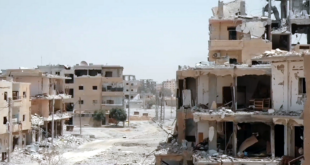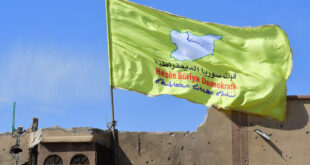
In a precedent, a car bomb on Thursday targeted the Russian military base in the village of Tal al-Samen, in the Syrian Democratic Forces (SDF)-controlled territory in eastern Raqqa province. More notable, however, was claiming responsibility for the operation by Hurras al-Din (Guardians of Religion) organization that is based in Idlib province in northwest Syria.
In a statement published on social media, Hurras al-Din announced its responsibility for what it called the “Raid of al-Usrah” (Raid of Difficulty), without providing any other details. While Russia remains silent about the attack, local opposition media reported it resulted in the deaths and injuries of several Russian soldiers.
A multifaceted message
Despite its limited scope, the Tal al-Samen operation bore a larger implicit message, especially as the first operation by Hurras al-Din outside of its main area of operation in the countryside of Idlib. The attack also serves as evidence of the failure of Abu Muhammad al-Jolani, the leader of Hayat Tahrir al-Sham (HTS), to hinder the organization and halt the growth of jihadist groups in areas he controls in northwestern Syria.
Hurras al-Din is a jihadist organization whose leadership broke off from HTS after refusing to cut ties with Al-Qaeda, becoming its branch in Syria. It is also on the United States list of terrorist organizations, and American warplanes and drones have targeted many of its leaders in the western countryside of Idlib and northern countryside of Latakia.
According to Orabi Abdelhay Orabi, a Syrian researcher specializing in religious and jihadist movements, the Tal al-Samen operation has political, military and security elements. Security comes to play in “the organization’s ability to penetrate SDF-controlled areas without its cells being detected in advance.” On the military level, although the operation “was essentially symbolic and not effective, it is the beginning of a new phase,” Orabi added. Meanwhile the political dimension appears to be a “shuffling of the cards against HTS after it failed to stop the activity of Hurras al-Din.”
Since the ceasefire agreement in northwestern Syria between Russia and Turkey in March 2020, HTS began to play a larger role as an undeclared local force implementing the agreement. It has played a primary role in pursuing and crippling jihadist organizations in particular, including preventing mergers between small jihadist factions outside of the scope of HTS, such as Hurras al-Din’s attempt to merge with other jihadist factions in the “Be Steadfast” operations room last June.
Apart from confirming the failure by HTS to undermine Hurras al-Din, the Tal al-Samen operation may mark the beginning of other operations targeting parties to the conflict outside of the opposition areas of northwestern Syria. In this context, Orabi did not rule out the possibility that “we see, for example, operations soon in Daraa” in southern Syria.
“Like all jihadist organizations, Hurras al-Din has had sleeper cells behind enemy lines for future coordination,” Orabi explained, as part of what is known “the jihad of the weak or spite, which has as its goal not empowerment or reaching strategic gains, but rather spite and revenge.”
Further, the Tal al-Samen operation indicates, according to Jordanian expert on Islamist groups Hassan Abu Haniyeh, that there has been “an evolution in the structure and activity of Hurras al-Din, following a period of dispute with HTS over influence and power, during which the organization was busy organizing its ranks.” This means that “the organization has begun to stabilize and make decisions at the strategic level, by choosing the nature of targets and type of suicide operations.”
Iran and ISIS factors
“Targeting a Russian military base is a change in the priorities of Hurras al-Din organization, which had focused more on regime forces and fighting the Americans,” according to Abu Haniyeh. This could “be related to tension in Russian-Iranian relations,” he added, pointing out that “Hurras al-Din, as we know, is linked to Al-Qaeda, and specifically the leadership of [Egyptian] Saif al-Adel, one of the leaders of Al-Qaeda in Iran.” Thus, there may be an “Iranian encouragement or facilitation of Hurras al-Din to strike the Russians.”
Besides, there is the possibility of coordination between Hurras al-Din and ISIS, including the transfer of members and fighters of the former to areas outside its control. This is supported by the existence of prior relationships between the fighters of the two organizations, who fought in the same groups in the past, according to Abu Haniyeh. “The far distance between areas of Hurras al-Din presence in western Idlib and where the operation was executed in Raqqa indicates cooperation and coordination with ISIS to reach the target site.”
However, such coordination “is not necessarily between the two organizations as a whole, but rather perhaps there are wings within Hurras al-Din that conduct some kind of operational and logistical coordination in these areas,” Abu Haniyeh said.
Undermining HTS
In addition to weakening al-Jolani, a potential aim of the attack in Raqqa, Abu Haniyeh said, is “to push or accelerate a Russian invasion of northwestern Syria” by providing Moscow with the excuse of fighting terrorist organizations in the region.
This would benefit Hurras al-Din, which “suffers more from HTS than it suffers from Russia and the regime” due to the restrictive policies pursued by HTS towards jihadist organizations in the areas of its control, Abu Haniyeh added. Also, such Russian invasion would allow “for Hurras [al-Din] to increase recruitment or cause split within HTS, especially since part of the leadership of HTS is not satisfied with the [Russian-Turkish] agreement [in northwestern Syria] and the way HTS deals with the regime and Turkey.”
On the contrary, Orabi believes that the Tal al-Samen operation does not justify a Russian retaliation in Idlib since the operation “took place in Raqqa and the SDF regions.” Additionally, “Turkey will not accept” a Russian attack on Idlib, “and will use the matter against the SDF,” he said.
“Even if Russia wanted to launch a military operation, it would collide with the military reality,” said Orabi. “Turkey has built a steel wall, so to speak, of military points, and the region has become extremely fortified,” so “why would Russia carry out an operation, knowing it would drag it into an ordeal, a plague, and the table may even turn on it in the region?”
The future of the Hurras al-Din-HTS relationship
The relationship between HTS and Hurras al-Din is already tense, characterized by harassment, siege and even arrests and assassinations of Hurras al-Din members and leaders. Nonetheless, the operation in Raqqa will likely raise the level of harassment the organization is exposed to since HTS may view it as a challenge to its power. Still, this will remain below the level of infighting, according to Orabi. HTS may arrest “some of the organization’s leaders again for questioning and torture, or they may even ask them to leave Syria,” he said.
According to Abu Haniyeh, given “the particularity of the operation, being against the Russians, Hurras [al-Din] are aware that it will embarrass al-Jolani with his fighters and with [other] nations.” So “al-Jolani will take security measures, but they will not be open, clear and widespread. However, he will make sure to send the message that ‘you will not act again without consulting us in strategic decisions such as this.’”
 Eurasia Press & News
Eurasia Press & News



